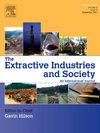国家一级能源部门对矿物需求建模的不确定性:以沙特阿拉伯为例
IF 4.3
2区 社会学
Q2 ENVIRONMENTAL STUDIES
Extractive Industries and Society-An International Journal
Pub Date : 2025-07-23
DOI:10.1016/j.exis.2025.101736
引用次数: 0
摘要
本文使用物质流模型来评估沙特阿拉伯在能源转型期间的物质需求,通过不同的需求、供应指标和假设,突出了国家层面估计的挑战。钢铁、铝和铜的吨位需求最高,但与目前的全球产量相比,电池材料和稀土元素的相对需求更大。该研究承认,由于技术部署等固有的不可知参数,估计范围很广。根据未来需求与全球生产和情景可变性的关系,提出了一种材料分类框架。确定了两类关键材料作为政策重点:高相对需求和低可变性的材料,以及高相对需求但高可变性的材料。后者需要适应性强的供应安全政策,以应对不断发展的技术部署。这种分类旨在指导决策者为这些潜在的关键材料制定有针对性的战略。本文章由计算机程序翻译,如有差异,请以英文原文为准。
Uncertainty in modelling the demand for minerals from the energy sector at a country-level: a case study of Saudi Arabia
This paper uses a material-flow model to assess Saudi Arabia's material demands during the energy transition, highlighting challenges in country-level estimation through varied demand, supply metrics, and assumptions. Steel, aluminum, and copper show the highest tonnage requirements, but battery materials and rare earth elements have larger relative demands compared to current global production. The study acknowledges a wide range of estimates due to inherently unknowable parameters like technology deployment. A material categorization framework is presented, based on future demand relative to global production and scenario variability. Two key material categories are identified for policy focus: those with high relative demand and low variability, and those with strong relative demand but high variability. The latter requires adaptable security of supply policies to address evolving technology deployments. This categorization aims to guide policymakers in creating targeted strategies for these potentially critical materials.
求助全文
通过发布文献求助,成功后即可免费获取论文全文。
去求助
来源期刊

Extractive Industries and Society-An International Journal
ENVIRONMENTAL STUDIES-
CiteScore
6.60
自引率
19.40%
发文量
135
 求助内容:
求助内容: 应助结果提醒方式:
应助结果提醒方式:


